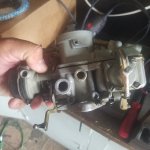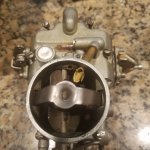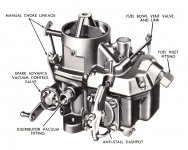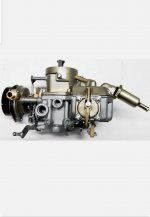Hello. I have a question for the group. I have a 1969 mustang with the 200 inline. I am having a hard time with locating a Carburetor. I need the autolite 1100 without the scv. I found 1 but the owner said it was for a manual car. Is there a difference between a manual trans carb and a auto ? I attached picture of one I currently have.
You are using an out of date browser. It may not display this or other websites correctly.
You should upgrade or use an alternative browser.
You should upgrade or use an alternative browser.
All Small Six Carb help
- Thread starter Jugger911
- Start date
This relates to all small sixes
is this the correct side for the SCV? I believe so, yet none is present. U can convert to non-scv.
Basicly the mani & auto carb for '68 + were the same. The auto hada 'choke pull-off' we used to pull off aahahahaaa. A lill 'dashpot to keep idle when off the gas (coasting).
Basicly the mani & auto carb for '68 + were the same. The auto hada 'choke pull-off' we used to pull off aahahahaaa. A lill 'dashpot to keep idle when off the gas (coasting).
Last edited:
Yes there is a difference as Chad stated. I have read but don’t know for sure that the anti stall dash pot is required for automatic cars.
"...I need the autolite 1100 without the scv..." I would call that "any post '68 Autolite 1100 (or 1101)". You don't need just a this specific carb. U can run others. If U have "the Handbook":
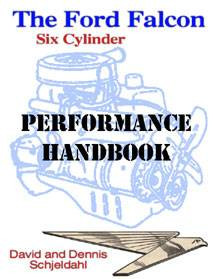
 www.vintageinlines.com
you'll C a 1/2 doz listed. I went to Mike's:
www.vintageinlines.com
you'll C a 1/2 doz listed. I went to Mike's:
 www.carburetor-parts.com
did some cross references and found off makes and models that worked (by cfm & bolt spacing). He's also a great resource for rebuild kits'n vids (told me he had thousands of them begun in '15).
www.carburetor-parts.com
did some cross references and found off makes and models that worked (by cfm & bolt spacing). He's also a great resource for rebuild kits'n vids (told me he had thousands of them begun in '15).
Often ppl ask Q here that have their own answ embedded in them. We run down a rd w/dead ends & all get frustrated ina mo or so. Stating the problem is often more useful - then allow the experienced to provide solutions - can B more satisfying in the end.
More help (free) tech archive, top blue line above:

The Ford Falcon SIX Cylinder PERFORMANCE HANDBOOK | Vintage Inlines
The Ford Falcon SIX Cylinder Performance Handbook has 107 pages of History, Facts, and Information to help you get more power out of your small Ford SIX. This engine was used in Falcons, Mustangs, Fairlaines, and Comets in the 60’s. It was the FoMoCo workhorse in Mavericks, Granadas, and...
Carburetor Parts by Make & Model
Often ppl ask Q here that have their own answ embedded in them. We run down a rd w/dead ends & all get frustrated ina mo or so. Stating the problem is often more useful - then allow the experienced to provide solutions - can B more satisfying in the end.
More help (free) tech archive, top blue line above:
Thank you for all the replies and links. I have the falcon book. I have looked in it and just ordered the new book from vintage inlines. The car has been in and out of shops my whole life. After college it was given to me. Im trying to get it up and running so my mom can enjoy it.
I guess this is where I'm confused. In 1969 ford put in a point -type centrifugal advance distributor. ( Ford I6 handbook pg.24. ) For 1968 & 69 The venturi was downsized to 1.1and scv was removed to accommodate the ' new ' distributor. I dont have the original carb the rebuilt one is all I have. there is a brass pickup tube that is split.
I have looked and found 1-2 without the scv. So my solution was buy a new rebuild pull the top cover and put it on my lower half. The rebuilt one i have doesn't have the vent rod valve. The new ones do. Does that matter ? Also I cant find anything thing that differentiates the manual vs auto in the carb. Can someone explain the difference or what to look for ?
I guess this is where I'm confused. In 1969 ford put in a point -type centrifugal advance distributor. ( Ford I6 handbook pg.24. ) For 1968 & 69 The venturi was downsized to 1.1and scv was removed to accommodate the ' new ' distributor. I dont have the original carb the rebuilt one is all I have. there is a brass pickup tube that is split.
I have looked and found 1-2 without the scv. So my solution was buy a new rebuild pull the top cover and put it on my lower half. The rebuilt one i have doesn't have the vent rod valve. The new ones do. Does that matter ? Also I cant find anything thing that differentiates the manual vs auto in the carb. Can someone explain the difference or what to look for ?
Attachments
AFAIH - automatic carbs with 'dashpot' slows the throttle return to idle to prevent automatics' T.C. engine loading from stalling when throttle closes quickly. Most auto' carbs use a simple spring/vac dashpot on the linkage.
After reading your carburetor and the car story my $.02 is simply look for a carb that is 'new old stock' or reliably freshened that matches the intake port and studs. You don't need the SCV or specifically the 1100 type carb. Any era Ford carb can work that fits - old carbs usually have worn parts, swapped parts, leaky shafts causing continued problems. Adapters bought or fabd' work and linkage isn't complicated.
Still wonderin':
,,, why SCV carbs which controlled only early distribs' are not considered usable since the SCV would be unused anyway ?.
... why better or later alternate carbs aren't generally used other than for true car 'originality' ?. Performance differences usually are less critical than drivability.
"Carburetor is said to be French for don't F%$K with it... "
have fun
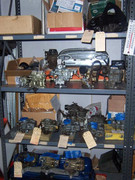

 .
. 
1904/2300/1100 tri-why?

The 'open to atmosphere' carb vent from fuel bowl was one of first noxious emission remediation's done at end of carburetor era. Earlier designs simple had a raised open hole in top of carb bowl. Fuel sloshing around while braking and cornering could slosh out and fuel vapor emission when shut down warm is part of typcal 'old car smell'.
Some old fuel bowl designs incorporated a 'stone filter' in bowl vent to slow down liquid leakage (Holley 1904). Later mods were like 1100's sometimes open vent (manifold vacuum?). Last of the carbs had sophisticated vacuum, temp. and elec. controlled vents either recirculating vapors to intake or diverting after shutdown to a remote charcoal canister - also used for fuel tank vapors.
After reading your carburetor and the car story my $.02 is simply look for a carb that is 'new old stock' or reliably freshened that matches the intake port and studs. You don't need the SCV or specifically the 1100 type carb. Any era Ford carb can work that fits - old carbs usually have worn parts, swapped parts, leaky shafts causing continued problems. Adapters bought or fabd' work and linkage isn't complicated.
Still wonderin':
,,, why SCV carbs which controlled only early distribs' are not considered usable since the SCV would be unused anyway ?.
... why better or later alternate carbs aren't generally used other than for true car 'originality' ?. Performance differences usually are less critical than drivability.
"Carburetor is said to be French for don't F%$K with it... "
have fun


 .
. 
1904/2300/1100 tri-why?

The 'open to atmosphere' carb vent from fuel bowl was one of first noxious emission remediation's done at end of carburetor era. Earlier designs simple had a raised open hole in top of carb bowl. Fuel sloshing around while braking and cornering could slosh out and fuel vapor emission when shut down warm is part of typcal 'old car smell'.
Some old fuel bowl designs incorporated a 'stone filter' in bowl vent to slow down liquid leakage (Holley 1904). Later mods were like 1100's sometimes open vent (manifold vacuum?). Last of the carbs had sophisticated vacuum, temp. and elec. controlled vents either recirculating vapors to intake or diverting after shutdown to a remote charcoal canister - also used for fuel tank vapors.
Last edited:
Yes there was a major change in the Ford Small Six distributors starting with 48 states 1968 models (in 1966 the Calif. Emissions cars as they got these new parts first) with the introduction of the better new Distributors with both centrical and vacuum advance systems. Yes along with this the Carb's also needed to be changed deleting the SCV system, for best results the Carb's and distributors need to be matched correctly. X2 Another change happened in 1969 with the introduction of the first large log heads that also had a larger 1 3/4 inch carb mounting hole going into the log and the mounting studs were spread apart wider too, making the older Carb's unable to bolt on without an adapter or on some Carb's you could slot the holes oblong to get them to fit. X2 Bowl vent rods were used on the early Autolite Carb's this allows air to be vented into the fuel bowl and its needed the Rod closed the bowl vent during times the engine wasn't running this cuts down on fuel bowl evaporation. But that early system would be all wrong for your 1969 Mustang as it has a compleatly different and better emissions system for venting of the fuel bowl and fuel tank. Your much better off staying with the newer 1969 Autolite Carb complete as it is. The 1969 Autolite 1101 was also the last year that any of these Autolites were used (so it's a One year only Carb) which is why you are having a hard time finding one.Thank you for all the replies and links. I have the falcon book. I have looked in it and just ordered the new book from vintage inlines. The car has been in and out of shops my whole life. After college it was given to me. Im trying to get it up and running so my mom can enjoy it.
I guess this is where I'm confused. In 1969 ford put in a point -type centrifugal advance distributor. ( Ford I6 handbook pg.24. ) For 1968 & 69 The venturi was downsized to 1.1and scv was removed to accommodate the ' new ' distributor. I dont have the original carb the rebuilt one is all I have. there is a brass pickup tube that is split.
I have looked and found 1-2 without the scv. So my solution was buy a new rebuild pull the top cover and put it on my lower half. The rebuilt one i have doesn't have the vent rod valve. The new ones do. Does that matter ? Also I cant find anything thing that differentiates the manual vs auto in the carb. Can someone explain the difference or what to look for ?
In your above picture of your carb that split brass tube your talking about is to vent air into the carbs fuel bowl, rather than changing Carb's or tops from older Autolite Carbs, it's much easier and at a lower cost if you just repair that part by cleaning it real good and then straightening it out that bent split side, next you just soldering it up. It will be fine after its repaired and will not effect the Carb's or cars operation as it's only function is to allow some nessisary air flow into the fuel bowl. If that the only reason your wanting to replace it than I would just repair what you have, since it is the correct year carb, for your 1969 Mustang.
Yes X2 Auto Trans Carb's are a little different from manual Trans Carb's but in your case as stated above it's only the dash pot that's needed for use with an Auto Trans. X2 Yes powerband is correct that all the Mustangs will have the Auto Trans kick down linkage that is mounted right on firewall mounted throttle linkage and it uses a short cable down to the trans kick down lever, no extra carb linkage is needed unlike on some other Ford models. If your Mustang has set unsed for a while a carb rebuild might also be needed or be a good idea. Best of luck
dash pot "... on the linkage...." not in body of carb.
LOM dizzy matches SCV carb. Get rid if both (easy way) & upgrade to a nicer-than-1100'n dizzy (ie ALL post '67). Time for reading the litrature'n study. U have the items to do that, the multiple garages did not. Learn 1st, attack later?
LOM dizzy matches SCV carb. Get rid if both (easy way) & upgrade to a nicer-than-1100'n dizzy (ie ALL post '67). Time for reading the litrature'n study. U have the items to do that, the multiple garages did not. Learn 1st, attack later?
That collection is impressive and motors.AFAIH - automatic carbs with 'dashpot' slows the throttle return to idle to prevent automatics' T.C. engine loading from stalling when throttle closes quickly. Most auto' carbs use a simple spring/vac dashpot on the linkage.
After reading your carburetor and the car story my $.02 is simply look for a carb that is 'new old stock' or reliably freshened that matches the intake port and studs. You don't need the SCV or specifically the 1100 type carb. Any era Ford carb can work that fits - old carbs usually have worn parts, swapped parts, leaky shafts causing continued problems. Adapters bought or fabd' work and linkage isn't complicated.
Still wonderin':
,,, why SCV carbs which controlled only early distribs' are not considered usable since the SCV would be unused anyway ?.
... why better or later alternate carbs aren't generally used other than for true car 'originality' ?. Performance differences usually are less critical than drivability.
"Carburetor is said to be French for don't F%$K with it... "
have fun

.
1904/2300/1100 tri-why?
The 'open to atmosphere' carb vent from fuel bowl was one of first noxious emission remediation's done at end of carburetor era. Earlier designs simple had a raised open hole in top of carb bowl. Fuel sloshing around while braking and cornering could slosh out and fuel vapor emission when shut down warm is part of typcal 'old car smell'.
Some old fuel bowl designs incorporated a 'stone filter' in bowl vent to slow down liquid leakage (Holley 1904). Later mods were like 1100's sometimes open vent (manifold vacuum?). Last of the carbs had sophisticated vacuum, temp. and elec. controlled vents either recirculating vapors to intake or diverting after shutdown to a remote charcoal canister - also used for fuel tank vapors.
I found one online I think. lol. So guy has it listed as for a manual transmission but it has the dash pots. I'd just like a second opinion it looks right by all my searches. but I could still miss something.
Attachments
Looks like it's right as much as I can tell but your original Carb in above pictures only shows the one side. Best of luck.
we'll hafta show him a pic of one "on the linkage", I got none.
To me the pic show the 'power valve' circular w/lever on right of 1st and L of 2nd, side of body... 'On the linkage" is seperate, off of the body and on a bail, rod or wire. Like a fat flying saucer, diphram in middle, button or pin sticking out a lill, pushed by the 'rod'. Never had 1 to play with, learn parts (names of this other carb).
Still waiting fr 2, 3 rows of ltrs/numbers by the down tube of the exhaust. Also on the flat part of the head (as seen 'from above". Just go round in circles (C note above) otherwise...
Can't write a book, ck on Mike's Carbs as he has lots of models. C "1968 Carter YF - ford falcon".
To me the pic show the 'power valve' circular w/lever on right of 1st and L of 2nd, side of body... 'On the linkage" is seperate, off of the body and on a bail, rod or wire. Like a fat flying saucer, diphram in middle, button or pin sticking out a lill, pushed by the 'rod'. Never had 1 to play with, learn parts (names of this other carb).
Still waiting fr 2, 3 rows of ltrs/numbers by the down tube of the exhaust. Also on the flat part of the head (as seen 'from above". Just go round in circles (C note above) otherwise...
Can't write a book, ck on Mike's Carbs as he has lots of models. C "1968 Carter YF - ford falcon".
Last edited:
Here is helpful information on the vent rod, from Mike: Autolite 1100 Vent Rod
Similar threads
All Small Six
SCV Check Ball
- Replies
- 5
- Views
- 409
- Replies
- 2
- Views
- 399
All Small Six
SCV Question
- Replies
- 3
- Views
- 570
- Replies
- 2
- Views
- 951
- Replies
- 34
- Views
- 2K

